
PREV ARTICLE
NEXT ARTICLE
FULL ISSUE
PREV FULL ISSUE
SELECTIONS FROM THE BEASLEY AND FAIRMONT SALEHere are some lots that caught my eye in the Stack's Bowers June 2018 Baltimore sales of the Beasley and Fairmont collections. -Editor
Lot 45: 1800 Capped Bust Right Half Eagle 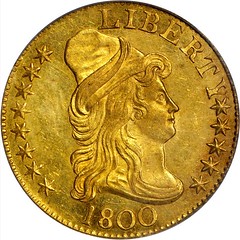  1800 Capped Bust Right Half Eagle. BD-2. Rarity-3+. Blunt 1. In the 2006 reference Early U.S. Gold Coin Varieties: A Study of Die State, 1795-1834, John W. Dannreuther estimates that the Mint struck 15,000 to 30,000 half eagles from 1800-dated dies. Although widely regarded as a type issue in the Capped Bust Right series, we caution bidders that the 1800 is scarce in an absolute sense, as are most pre-1834 U.S. gold issues. Those that are not scarce are rare. Only 175 to 250 examples of BD-2 are believed extant in all grades, underscoring the significance of this offering for Mint State type collectors and early half eagle enthusiasts. What's not to like about a nice high-grade early gold piece? -Editor
To read the complete lot description, see: Lot 1013: W. LEVIS Counterstamp 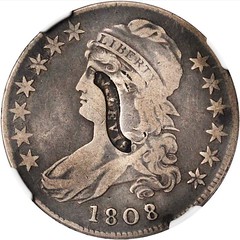 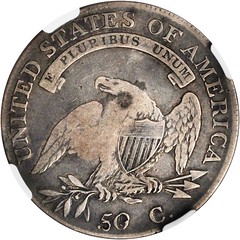 Pennsylvania--Philadelphia. W. LEVIS on an 1808/7 Capped Bust half dollar. Brunk L-313, HT-906. Rarity-7. The counterstamp in a curved ribbon is neatly centered in the center of the obverse, directly over Liberty's head and neck. The host coin is richly and originally toned with ample boldness of detail remaining in all areas save for on the reverse opposite the counterstamp. The NGC qualifier concerns a few tiny digs on the reverse that have warped the appearance of the digits 50 in the denomination. Brunk reports only two examples of this counterstamp on half dollars--coins dated 1807 and 1826--while Rulau lists just three--1807, 1818, 1826. The present host coin, an 1808/7, is unlisted in either reference. 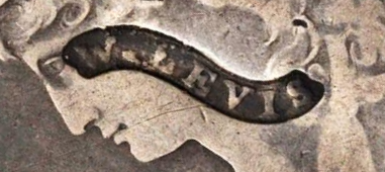 Th curved ribbon logotype is what caught my eye - it is a very rare format, and I'm hard pressed to think of another. Can anyone identify one? -Editor
To read the complete lot description, see: Lot 1036: 1787 Immunis Columbia Copper 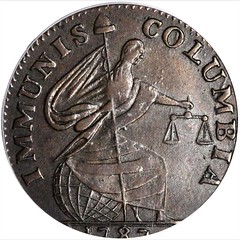 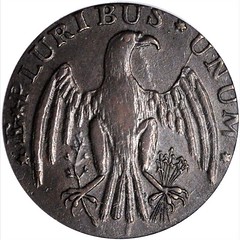 1787 Immunis Columbia Copper / Large Eagle Reverse. W-5680. Plain Edge, Narrow Planchet. The origin of the Immunis Columbia coppers is not known, but they are clearly tied in with the Nova Constellatios and the Vermont coppers. This would seem to place their origin here in America, but it is possible they are from England as thought by Walter Breen. Likely intended for circulation, most survivors show considerable wear, making the present specimen a real treat. If these had been intended as a proposal for contract coinage it would seem that fewer would have been struck and higher grades would be the norm. A few are known to have been overstruck on New Jersey coppers (all Maris 26-S) which also lends credence to their American origin. A great, high-grade coin. Very nice! -Editor
To read the complete lot description, see: Lot 1090: 1857 Flying Eagle Cent  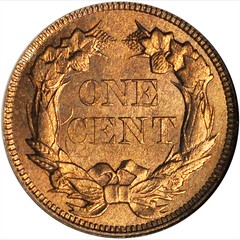 The brief regular issue Flying Eagle cent series comprises just two circulation strike issues, the 1857 and 1858 both readily available in grades through MS-64. Gems are scarce, however, and the lovely example offered here sure to have no difficulty finding its way into a high quality type set. Nice coin. -Editor
To read the complete lot description, see: Lot 1242: 1829 Capped Bust Half Dime 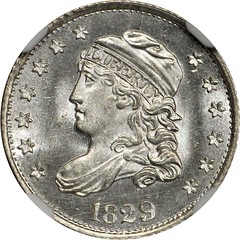  The first half dime struck since 1805 and the first issue in the Capped Bust series, the 1829 is very popular for type purposes. Fortunately, enough examples were set aside at the time of production or otherwise managed to survive without seeing commercial use that acquiring an Uncirculated coin in grades through MS-64 should prove relatively easy under normal market conditions. A beauty! -Editor
To read the complete lot description, see: Lot 1310: 1834 Capped Bust Quarter 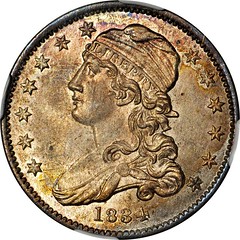 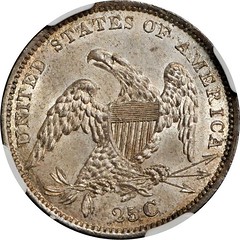 The cornerstone of the second Philadelphia Mint building on Juniper and Chestnut streets was laid on July 4, 1829, by Mint Director Samuel Moore. At around the same time, the Mint, in its existing facility, introduced several technological improvements to its processes, chief among which was the close collar (a.k.a. "collar die") which simultaneously imparted reeding to the coins' edges (when desired) and gave them a uniform diameter during striking. The first coins produced using this innovation were the Capped Bust half dimes of 1829, a denomination not produced since 1805. The first chance to utilize the close collar for the quarter came in 1831, there being no examples of this denomination struck in 1829 or 1830. To prepare the quarter for close collar production, Engraver William Kneass modified the existing Capped Bust design by John Reich to allow it to fit onto smaller planchets of uniform diameter. Kneass refined the portrait and eagle, removed the scroll upon which the Latin motto E PLURIBUS UNUM had been inscribed, and added a raised border around both sides. This type has since become known to numismatists as the Reduced Diameter, Reduced Size or, more informally, Small Size Capped Bust quarter. It was produced from 1831 through early 1838. Like its Large Diameter predecessor of 1815 to 1828, this type is among the more underrated in U.S. numismatics. To read the complete lot description, see: Lot 1593: 1916 Mercury Dime Pattern It's a shame this one saw so much circulation. Interesting coin nonetheless. For comparison, here's a regular issue 1916 dime from NGC Coin Explorer. -Editor
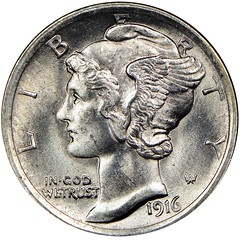  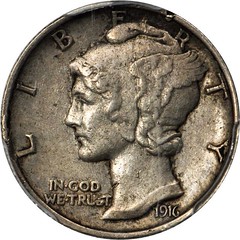  1916 Pattern Mercury Dime. Judd-1794/1983, Pollock-2042. Rarity-8. Silver. Reeded Edge. AU Details--Damage (PCGS). Obv: Similar to the adopted Mercury type, but without the designer's initials in the right field. The date is entirely under Liberty's shoulder, the neck truncation is short and distant from the rim, and more of the letter E in LIBERTY is visible than on the regular issue of the date. Pellets divide the words IN GOD and WE TRUST in the motto, though the letters of the motto do not have any serifs. Rev: Also similar to the adopted Mercury type, although the foliage in the olive branch is arranged somewhat differently. There is an extra sprig of three leaves in the branch to the right of the letter E in ONE, though it is somewhat obscured by the abrasions on this particular example. A collection of old, seemingly-nonsensical pinscrapes populate the reverse fields, though the surfaces are otherwise wholesome. The complexion is predominately dove-grey, revealing a faint vanilla iridescence at a tilt. Now Judd-1983, formerly Judd-1794 in earliest editions of the Judd reference. In 1916, pattern Mercury dimes, Standing Liberty quarters, and Walking Liberty half dollars were all produced. They all closely resembled the regular-issue pieces of the year, and many of the known pattern examples of all three denominations were either spent during the Great Depression or simply lost to time. It's obvious that the present specimen saw a good deal of circulation before being plucked from circulation, though it now represents one of just two examples known from these dies. To read the complete Coin Explorer entry, see: MERCURY DIMES 1916 MERCURY 10C MS (https://www.ngccoin.com/coin-explorer/mercury-dimes-pscid-31/1916-mercury-10c-ms-coinid-14904) To read the complete lot description, see: Wayne Homren, Editor The Numismatic Bibliomania Society is a non-profit organization promoting numismatic literature. See our web site at coinbooks.org. To submit items for publication in The E-Sylum, write to the Editor at this address: whomren@gmail.com To subscribe go to: https://my.binhost.com/lists/listinfo/esylum All Rights Reserved. NBS Home Page Contact the NBS webmaster 
|